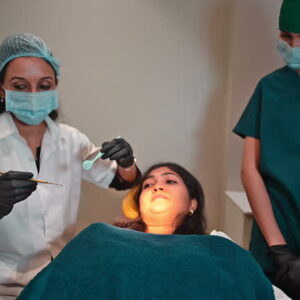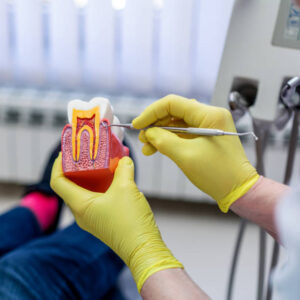Tooth sensitivity is quite common after fillings. Filled teeth may be sensitive to stimuli such as stress, sweets, and temperature. This sensitivity usually disappears on its own within a few weeks. During the sensitive period, it is enough to avoid stimulation as much as possible. Painkillers are generally not required.
If your tooth sensitivity does not resolve within two to four weeks, or if your teeth are very sensitive, contact your dentist. He/she may recommend desensitizing toothpaste, desensitizing agents for teeth, and may suggest root canal therapy.
Discomfort after dental fillings are generally as follows:
- Pain caused by filling
Pain when the bite or the cusps of the teeth meet. This type of pain comes on quickly after the anesthesia wears off, occurs while chewing food, and lasts for a while. When this pain occurs, it indicates that the filling is interfering with the occlusal relationship of the teeth, and you will need to have a follow-up visit and a filling. If the pain persists, it may indicate the need for root canal treatment.
Hot and cold stimulation pain. This pain is very severe and only occurs when the tooth touches something cold or hot, and the pain goes away when the hot and cold stimulation is removed. If the pain persists for a long time after the hot and cold stimulation is removed, there may be irreversible damage to the nerve, in which case a dentist should be consulted.
Constant throbbing pain. If there is a deeply decayed root, this pain may indicate that the pulp tissue may no longer be healthy and may require root canal treatment. It maybe needs the endodontic post for supporting the whole teeth.
Referred pain (sensitivity or pain in the tooth adjacent to the filling). Aside from the characteristic pain, there seems to be no other problem with the denture. This is because the filled tooth transmits pain signals to other teeth, and the pain should resolve on its own within one to two weeks.
- Allergic reaction caused by silver amalgam filling
Allergic reactions to silver fillers are very rare. Fewer than 100 cases have been reported, according to the American Dental Association. This allergic reaction may be caused by other metals such as mercury. Amalgam allergy symptoms are similar to typical skin allergy symptoms, including skin rash and itching. Patients allergic to mercury often have a medical or family history of metal allergy. If the allergy is confirmed, it can be filled with another restorative material.
- Problems caused by inferior filling materials
The pressure from constant chewing, grinding, and clenching can wear down the fillings. While you don’t know your tooth’s fillings have worn down, your dentist can diagnose defects in restorations during regular health check-ups.
If the adhesive between the enamel and the filling is split, food debris and cariogenic factors can enter the gap, causing secondary caries.
If the filling area is large or there is secondary caries, the remaining tooth tissue may not be enough to support another filling. In these cases, the dentist may need to replace the filling with a crown restoration.
The new filling may fall off, possibly because the repair material breaks under the action of chewing or biting. Older restorative materials usually suffer from decay due to caries or the fracture of remaining teeth.
Therefore, dental restoration is not done once and for all, and it is also necessary to conduct regular inspections after restoration to detect problems early and deal with them in time.
Precautions after fillings: how to care after fillings
- Pay attention to brushing your teeth. After fillings, do not brush too hard or too fast. On the day after the resin filling, do not brush your teeth to avoid touching and causing the filling material to fall off.
- Be careful when chewing. Although the shape of the tooth can be restored after filling, the chewing performance of the tooth is damaged to a certain extent. Therefore, it is not suitable to chew hard food after filling, and the side of the filling cannot be used for chewing at the initial stage after filling.
- The diet should be coordinated. After fillings, do not eat cold or hot food. It takes a certain amount of time for the filling material to solidify. Therefore, you should not eat within 2 hours after filling. For 2 hours after filling, you can eat some light, mild liquid food and semi-liquid food, such as milk, bread, porridge and soup.
- Oral hygiene should be done well. Although dental caries can be controlled after filling, if you do not pay attention to oral hygiene, caries can still occur. Therefore, oral hygiene care is extremely important. In daily life, you should pay attention to brushing your teeth in the morning and evening, gargle after meals, do a good job in oral hygiene, and conduct regular oral examinations.
- Special circumstances require special protection. For large-area-deficient teeth with more serious caries, after resin filling, tooth fractures are often prone to occur during chewing due to insufficient resistance of the tooth itself. Do timely crown protection of the affected tooth to prevent tooth fracture.
- Discomfort after filling should be treated. If there is mild pain after filling, you can first observe yourself, and some mild discomfort and pain may disappear on their own. If the pain is not relieved, but further aggravates, or there is occlusal pain, throbbing pain, hot and cold stimulation pain, and spontaneous pain at night, you should go to the hospital for follow-up examination and treatment in time to find out the cause and eliminate the pain.
Matters needing attention after filling: different materials need to pay attention
After filling your teeth, it doesn’t mean you will be fine. You can do it once and for all. If you don’t pay attention to some things after filling your teeth, the effect of filling your teeth will not be achieved, and your teeth will still be damaged. So, what are the precautions after a dental filling? Depending on the filling material, the situation to pay attention to is also different.
- Light curing composite resin
(1) Do not brush the surface of the restoration with a rough toothbrush within a week, because the curing degree of the resin is only 50% due to light curing, 90% within 24 hours, and 100% after 7 days.
(2) Do not bite hard objects with the restoration, drink less strong tea, smoke less, and avoid using metal stimulation to rub the restoration surface to avoid coloring of the restoration.
(3) If you feel unwell, please call the doctor (consultation) at any time.
- Silver tribute filling
Because the volume change of the filling can be stabilized after 24 hours, it is not allowed to chew hard food with the restored tooth within 24 hours, so as to prevent the filling from breaking and falling off.
- Glass ion filling
The glass ion can be completely solidified after 24 hours, so it can be used for therapeutic chewing after 24 hours. When chewing, you should eat some soft food first, and gradually adapt to it.
- Pit and fissure closure
Because the sealant in the deep part of the pit and fissure is generally completely cured within 7 hours, it is forbidden to chew food with closed teeth and avoid biting too hard and coarse food within 2 hours of fasting.
Before filling restoration treatment, dentist should use proper size of FG carbide burs to clean and cut the crown for the next steps of filling materials ready. In the next step, the dentist will use composite matrix bands for the restoration materials filled in the hole.






